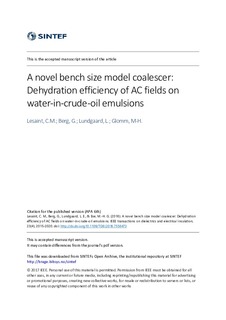| dc.contributor.author | Lesaint, Cedric Michel | |
| dc.contributor.author | Berg, Gunnar | |
| dc.contributor.author | Lundgaard, Lars Esben | |
| dc.contributor.author | Ese, Marit-Helen Glomm | |
| dc.date.accessioned | 2018-05-02T10:16:08Z | |
| dc.date.available | 2018-05-02T10:16:08Z | |
| dc.date.created | 2016-09-26T13:15:16Z | |
| dc.date.issued | 2016 | |
| dc.identifier.citation | IEEE transactions on dielectrics and electrical insulation. 2016, 23 (4), 2015-2020. | nb_NO |
| dc.identifier.issn | 1070-9878 | |
| dc.identifier.uri | http://hdl.handle.net/11250/2496665 | |
| dc.description.abstract | We describe herein the design of a small AC electrostatic model coalescer for investigating coalescence efficiency of water in oil emulsions. The function of the model coalescer is tested on emulsions with different water cuts. In the coalescer, coalescence takes place in a couette flow in the bulk emulsion. The electric field has a high utilization factor, and the electrodes are insulated to avoid drop charging. The set-up allows for independent setting of retention time and shear rate of the emulsion. Temperature can be adjusted up to 80 °C, and AC voltage level, frequency and shape can be varied. Efficiency is measured optically and by checking speed of water precipitation. Several parameters have been studied to determine their influence on the electrostatic dehydration process of water-in-crude-oil emulsions. Temperature, wave form, water content, droplet size but also rotational speed were found to play an important role in the process according to what was expected theoretically. © IEEE | nb_NO |
| dc.language.iso | eng | nb_NO |
| dc.rights | Navngivelse 4.0 Internasjonal | * |
| dc.rights.uri | http://creativecommons.org/licenses/by/4.0/deed.no | * |
| dc.title | A novel bench size model coalescer: Dehydration efficiency of AC fields on water-in-crude-oil emulsions | nb_NO |
| dc.type | Journal article | nb_NO |
| dc.type | Peer reviewed | nb_NO |
| dc.description.version | acceptedVersion | nb_NO |
| dc.rights.holder | Authors have copyright to accepted version | nb_NO |
| dc.source.pagenumber | 2015-2020 | nb_NO |
| dc.source.volume | 23 | nb_NO |
| dc.source.journal | IEEE transactions on dielectrics and electrical insulation | nb_NO |
| dc.source.issue | 4 | nb_NO |
| dc.identifier.doi | 10.1109/TDEI.2016.7556473 | |
| dc.identifier.cristin | 1385596 | |
| dc.relation.project | Norges forskningsråd: 206976 | nb_NO |
| cristin.unitcode | 7548,30,0,0 | |
| cristin.unitname | Elkraftteknologi | |
| cristin.ispublished | true | |
| cristin.fulltext | postprint | |
| cristin.qualitycode | 2 | |

